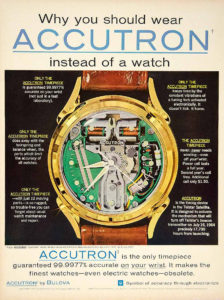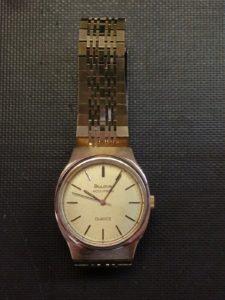
On October 26, 1866, a Frenchman named Louis F. Breguet received a patent for a watch that ran on a tuning fork. He was, shall we say, just a bit ahead of his time, although he did manage to produce a prototype.
94 years later, another inventor named Max Hetzel saw his own version of the tuning fork watch see public release as the Bulova Accutron.
Hetzel, raised in Switzerland under very modest circumstances, used to comb the city dump for parts to make things. Early in life, he realized that engineering was his calling. His inventive mind earned him over 100 patents.
Switzerland was renowned for producing the world’s most accurate watches. But mechanical works powered by a balance wheel had a ceiling on accuracy. The most expensive watches in the world could guarantee an accuracy of perhaps five minutes per month. And while that was very good, it still meant that watches were off by a number of seconds no matter how often they were synchronized.
It took the recent invention of transistors to make an electronic watch feasible. In 1953, Hetzel created a handmade prototype watch using the transistors and a tuning fork. Its accuracy was far better than anything devised to that point. But they required further innovation: a battery small enough and powerful enough to make the watch commercially successful.
Mallory obliged with miniaturized batteries in 1954. By 1955, eight prototype electronic watches were created. Arde Bulova, president of the company, became enthused over the possibility of leapfrogging the competition for the title of producer of the world’s most accurate watch. He directed funding to get all the bugs worked out and to get such a remarkable device on the market.
Hetzel received a promotion and moved to the United States in 1959, spending all of his time on the new watch concept. On October 10th, 1960, Bulova’s new president, none other than former general Omar Bradley, announced the Bulova Accutron Caliber 214, the first electronic watch ever offered for sale to the public.

The watch was a trailblazer. It only had twelve moving parts, and its accuracy blew away the finest mechanical watches in the world. And its cost was not beyond the reach of the middle class.
It was an instant hit, and Bulova advertised it as an Accutron, which is a device more sophisticated than a mere wristwatch. It came with an elaborately printed guarantee that it would be accurate to within a minute per month.
The space age contributed to its success. Bulova was proud to advertise the fact that NASA relied upon its superhuman accuracy for its missions. In fact, Buzz Aldrin had an Accutron on his wrist when he set foot on the moon in 1969. One of the reasons it was selected for use in space was because effects on traditional mainspring-driven watches from zero gravity were unknown. A nice, electrically-powered tuning fork was much more predictable.
The Accutron sold over four million units before it was discontinued in the year I graduated high school, 1977. By then, quartz digital watches were making a minute a month look amateurish. And their prices were nosediving, as well.
But the Bulova Accutron stands today as an innovation that provided the most accurate wristwatches in the world for over fifteen years. Pretty remarkable stuff from a brilliant man who used to scrounge through the city dump for his raw materials.
I am curious as to what you know about the “Vintage Accutron” you have pictured? I have the exact same watch. It was my great-grandfathers.
Nothing other than what I wrote in the article, I’m afraid.
Great article, and thanks for the reply. I was able to figure out the year, series, and model.
1977 BULOVA ACCUTRON QUARTZ 242 2421.11